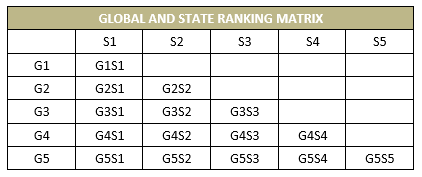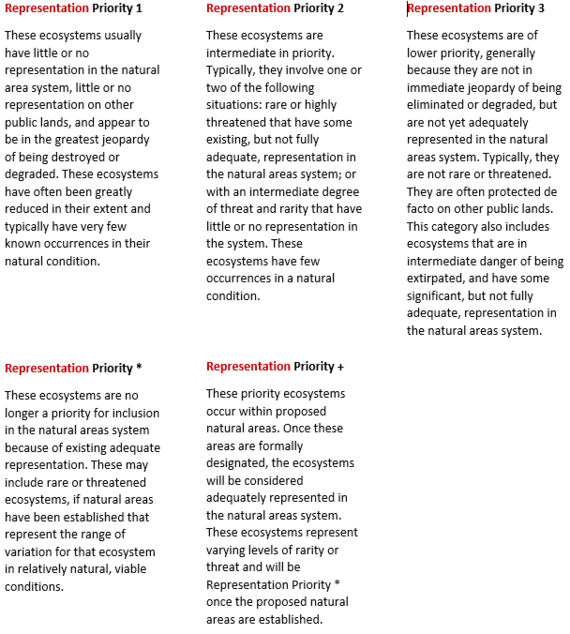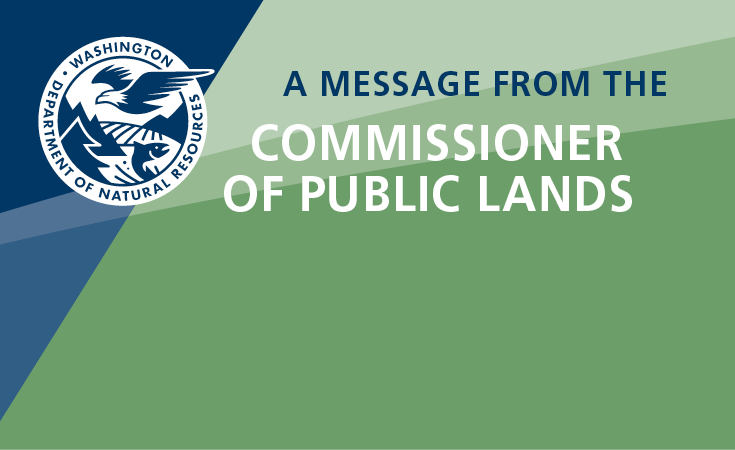
Natural Heritage Methods
The Washington Natural Heritage Program's (WNHP) approach to conservation addresses three questions:
- What are the components of biodiversity (classification)?
- Where do the various components occur (inventory)?
- What needs to be done to protect the individual components (conservation planning)?
These questions are addressed in an ongoing and iterative manner. Each step—classification, inventory, and conservation planning—is repeated as more information is gathered and as conservation actions take place.
1. Classification: Identifying and Assigning Conservation Priorities to the Components of Biodiversity
Natural Heritage Programs make use of what has been called a “coarse filter / fine filter” approach to account for the different components of biodiversity. The coarse filter consists of all of the ecosystems (both terrestrial and aquatic) occurring within the state. The fine filter consists of rare species and rare ecosystems that may not be adequately protected by using only the coarse filter.
The basic assumption of this approach is that by ensuring the conservation of ecosystem types, the conservation of the common species that make up those types can be achieved in an efficient manner. Species and ecosystems that are rare or have very limited distributions warrant their own specific conservation efforts.
The success of this approach is dependent upon several factors, including having a well-developed classification of ecosystems, gaining protection for not only all ecosystem types, but for the full range of variability within each ecosystem type, and ensuring that the list of fine filter features includes all species and ecosystems that might not be ‘captured’ by applying the coarse filter. And of course, conservation efforts, if they are to be successful, must account for the various ecological processes that influence species and ecosystems.
Establishing clear priorities for species and ecosystems is critical to successful conservation. WNHP currently uses two approaches to prioritize species and ecosystems:
Global and State Ranking System - for overall conservation action
Assigning Priorities to Species and Ecosystems - specifically for including species and ecosystems within the statewide system of natural areas
Both approaches make use of the objective methodology of WNHP, helping to achieve both effectiveness and efficiency in conservation efforts.
Global and State Ranking System
The primary tool used to develop priorities for individual species is the global and state ranking system used by NatureServe and its member Natural Heritage programs. The ranking system facilitates a quick assessment of a species’ rarity. Each species is assigned both a global (G) and state (S) rank on a scale of 1 to 5. The global ranks are assigned through a collaborative process involving both NatureServe and individual Natural Heritage Program scientists. State ranks are assigned by scientists within the Natural Heritage Program, who collaborate with other scientists and knowledgeable individuals.
A rank of G1 indicates critical imperilment on a global basis; the species is at great risk of extinction. S1 indicates critical imperilment within a particular state (in our case, Washington), regardless of its status elsewhere. A number of factors, such as the total population size, the number of occurrences, threats, etc., contribute to the assignment of global and state ranks. The information supporting these ranks is developed and maintained by the Natural Heritage Program and NatureServe.
The table below shows the matrix of possible combinations of global and state ranks. Note that some combinations are not possible: a feature cannot be more common in the state than it is for the entire planet.

| Global and State Ranking Definitions | Global and State Ranking Factors for Species |
| 1 Critically imperiled | • Total number and condition of occurrences |
| 2 Imperiled | • Total population size |
| 3 Vulnerable to extirpation or extinction | • Range and extent of area occupied |
| 4 Apparently secure | • Short- and long-term trends in factors above |
| 5 Widespread, abundant and secure | • Threats |
| • Vulnerability |
Assigning Priorities to Species and Ecosystems
How are Priorities Assigned to Species?
The global and state ranking system is the starting point for assigning priorities to species and ecosystems for inclusion within the statewide system of natural areas. The global and state ranking matrix (above) is used as the framework for assigning priorities. It is important to note that the matrix is used as a guideline only. A number of factors are considered for each species prior to final assignment of a priority. These factors are used to either elevate or lower the priority of individual species. Factors include:
- Is the species suspected of being more widespread than the data indicate?
- Does the distribution pattern (local endemic, peripheral, disjunct, isolated populations, etc.) convey more or less concern?
- Are demographic issues (small populations, declining populations, poor reproduction, etc.) significant?
- Are habitat issues (habitat declining, dependence on natural disturbance, habitat restricted but not threatened, etc.) significant?

How are Priorities Assigned to Ecosystems?
As with rare species, the starting point for assigning a priority to each ecosystem for its inclusion within the statewide natural areas system is its global and state rank. Such ranks have been assigned to all terrestrial ecosystems and some of the wetland and aquatic ecosystems. Marine ecosystems have not as yet been assigned global or state ranks. However, there is not a straightforward correlation between global and state rank and priority, as there is with species. Ecosystem priorities are based on three criteria:
- How adequately the ecosystem type is represented in the natural areas system.
- Rarity of the ecosystem type.
- Degree of threat to the ecosystem type.
The task of adequately conserving all ecosystems in Washington is considerably greater than getting representation of all ecosystems in the natural areas system. That is, representation is a more immediate, and achievable, goal than is conservation.
Achieving conservation of all of our native ecosystems will require use of all available conservation tools. Natural areas are meant to provide protection for the best quality representative examples. Not only do these examples contribute to conservation, but they are meant to provide baseline reference sites to be used to help guide management and restoration of other areas.

2. Inventory
Information on rare species and ecosystems comes from a wide variety of sources. Federal and state agency biologists submit information on priority species. Members of the Washington Native Plant Society and other conservation organizations provide sighting information. Consultants submit data to our program. The Washington Rare Plant Care and Conservation program at the University of Washington also provides updated information on species occurring on public lands. And, of course, WNHP scientists conduct field inventories for high priority species and ecosystems. Our staff also glean both site-specific and species/ecosystem-specific information from published literature.
3. Conservation Planning
Information housed in the Natural Heritage Information System is being applied to the full range of conservation tools by a variety of agencies, organizations and individuals. See our Conservation Planning page for more information.


